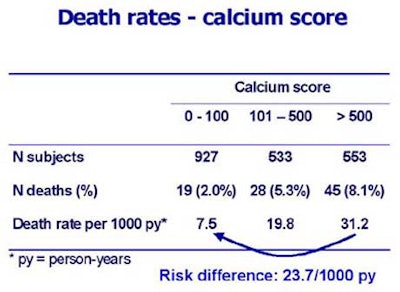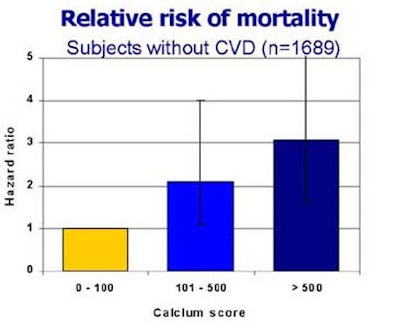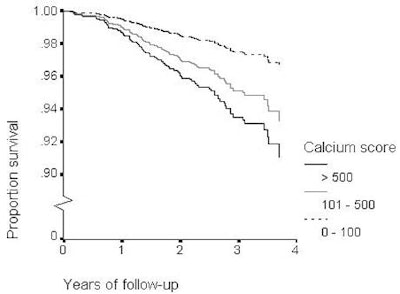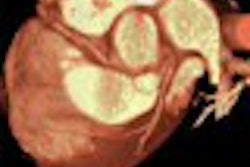
VIENNA - The final chapter on coronary calcium scoring won't be appearing in bookstores anytime soon; at times it seems the authors have barely made it past the prologue.
For although scoring has shown significant value for predicting the risk of some coronary events, questions remain about the validity of the scores, the relative merits of electron-beam versus multislice CT, interscanner variability, and the many problems associated with multiple software scoring and analysis packages capable of yielding very different scores in the same patient.
Perhaps the thorniest questions surround the populations that undergo scoring. Studies showing a higher risk of coronary events in patients with higher calcium scores have been criticized for not limiting their studies to subjects aged 40 or under, where the presence of any calcium is thought to be more significant as an isolated risk factor, and more useful in treating atherosclerosis while there's still time to affect outcomes.
Still, add a large population-based study like the one presented Friday at the 2002 ECR meeting, and you've got a real page-turner. Researchers from University of Groningen Hospital in The Netherlands found that coronary calcium is a strong predictor of mortality that is independent of other cardiovascular risk factors. At the least, the study suggests that the calcium puzzle, while difficult, is well worth solving.
"Previous investigations have shown that the amount of coronary calcification is closely related to the ... extent of coronary artery disease," said radiologist and lead researcher Dr. Rozemarijn Vliegenthart. "However, the question is whether coronary calcification predicts cardiovascular morbidity and mortality."
The three-year study by Vliegenthard and colleagues was based on a cohort of the larger Rotterdam Study of coronary disease in the elderly. Vliegenthard's team sought to investigate the determinants and consequences of coronary calcification as detected on electron beam CT (EBCT). In all, 2,063 of 3,371 eligible patients, ages 55 to 85 with a mean age of 77, underwent EBCT calcium scoring between 1997 and 2000, and complete data were obtained for 2,032 subjects.
The subjects were also asked about smoking habits and medication use, and their height, weight and blood pressure were measured. Total cholesterol, LDL cholesterol, and glucose were also determined, based on fasting blood samples.
For each subject, spiral CT images of the entire heart were acquired in a single breathhold, using ECG triggering at 80% of RR cycle, in 38 slices of 3 mm, 100 ms, with a 260-mm field of view. Software scores were measured using Accuimage software, and the study defined coronary calcification as density of 130 HU on a minimum of two adjacent pixels. The patients were then divided into 3 categories based on calcium score: less than 100, 100 to 500, and over 500, and the subjects were then followed up until the date of death, or until December 31, 2001.
The mean follow-up duration was 2.7 years, during which time 92 subjects died.
"We used Cox regression analysis, adjusted for age and sex, to compute survival curves and hazard ratios, and we repeated this analysis for cardiovascular risk factors," Vliegenthart said. "To give you an impression of the distribution of calcium scores, 47% of the (subjects) had calcium scores between 0 and 100. Twenty-six percent had scores between 100 and 500, and 27% had calcium scores above 500."
 |
Calcium score was strongly associated with mortality. Over the follow-up period, the increase in mortality between the lowest and the middle category of calcium scores (0-100 and 101-500) was 12.3%; and between the middle and the highest scores (101-500 and >500) was 23.7 per 1,000 person years.
After adjusting for age and sex, increased calcium scores were clearly associated with a decrease in survival. Subjects with calcium scores between 101 and 500 were at a double risk of mortality compared to the reference category, and subjects with calcium scores over 500 were at 2.7 times increased risk of mortality. This analysis was repeated after excluding those subjects (16%) with a history of cardiovascular disease. Coronary calcification in those with scores over 500 was still associated with 3.1 times the risk of death compared with the lowest-scoring group.
Moreover, coronary calcium was a significant risk factor for mortality even when assessed independently of other coronary risk factors, she said. In the multivariate-adjusted relative risk, only age was a higher risk factor for death than calcium score.
 |
Some points need discussion, she said. "Our investigations were performed in an elderly population. It's well known that the event risk increases however you do the follow-up. Our results suggest that coronary calcification may be just one of these markers. Furthermore, sometimes it's difficult to assess the specific cause of death in the elderly."
 |
 |
Regarding the decision to create the three calcium score categories with no category for zero, it reflected the elderly study population, where there were few subjects with no coronary calcium, she said. There were two subjects who died with a calcium score of zero.
"Coronary calcium represents a strong risk of mortality which is independent of other coronary risk factors, she concluded. "Our results suggest that coronary calcium may be a better tool to identify the elderly at highest risk of morbidity and mortality than cardiovascular risk factors."
Taking the results with a grain of salt, Vliegenthart said that coronary calcium might appear to be a good predictor of mortality only because other cardiovascular risk factors are worse predictors at that age.
"I think we have to consider that this is an elderly population with a mean age of 71 years," she said. "Cardiovascular risk factors do not predict morbidity and mortality very well in elderly people; it may be because the most vulnerable people have already died from cardiovascular risk factors. For instance, cholesterol levels when they drop in the elderly also increase the risk, because they are a marker of less health."
By Eric BarnesAuntMinnie.com staff writer
March 1, 2002
Related Reading
High calcium scores linked to dramatic increase in coronary event risk, January 24, 2002
CT calcium scoring works, but what does it mean?, January 8, 2002
MDCT yields reliable results for coronary calcium screening, November 28, 2001
Do CT and EBCT calcium scores weigh apples and oranges?, October 12, 2001
Copyright © 2002 AuntMinnie.com




















